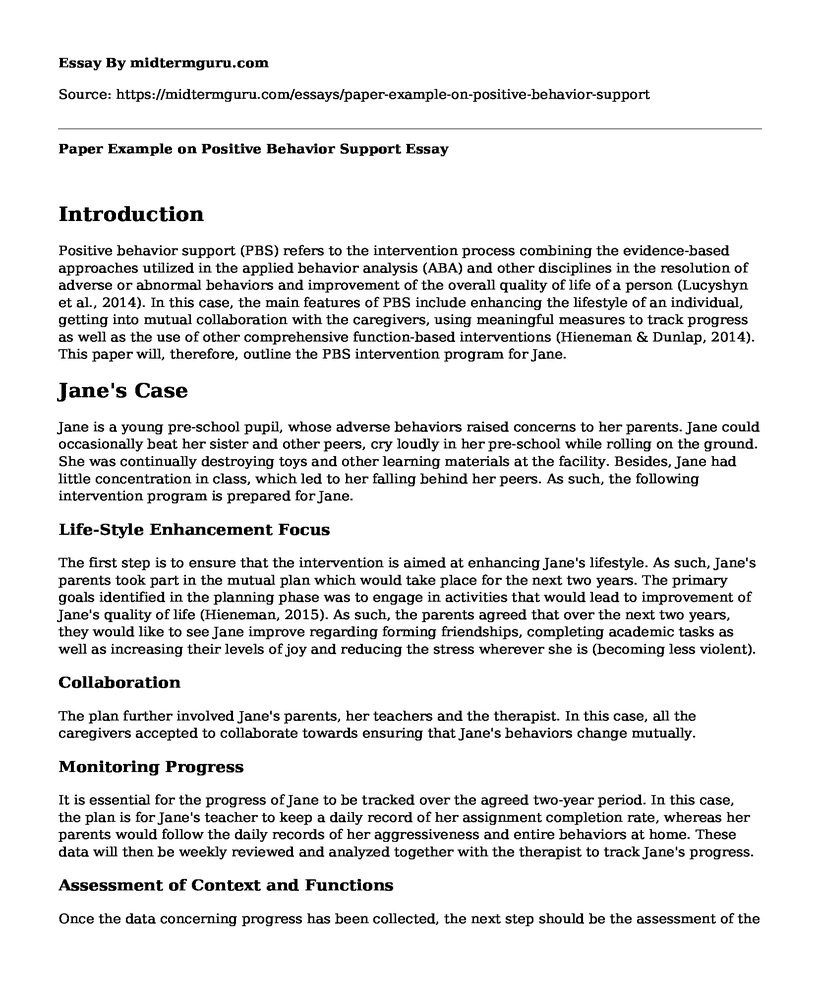Introduction
Positive behavior support (PBS) refers to the intervention process combining the evidence-based approaches utilized in the applied behavior analysis (ABA) and other disciplines in the resolution of adverse or abnormal behaviors and improvement of the overall quality of life of a person (Lucyshyn et al., 2014). In this case, the main features of PBS include enhancing the lifestyle of an individual, getting into mutual collaboration with the caregivers, using meaningful measures to track progress as well as the use of other comprehensive function-based interventions (Hieneman & Dunlap, 2014). This paper will, therefore, outline the PBS intervention program for Jane.
Jane's Case
Jane is a young pre-school pupil, whose adverse behaviors raised concerns to her parents. Jane could occasionally beat her sister and other peers, cry loudly in her pre-school while rolling on the ground. She was continually destroying toys and other learning materials at the facility. Besides, Jane had little concentration in class, which led to her falling behind her peers. As such, the following intervention program is prepared for Jane.
Life-Style Enhancement Focus
The first step is to ensure that the intervention is aimed at enhancing Jane's lifestyle. As such, Jane's parents took part in the mutual plan which would take place for the next two years. The primary goals identified in the planning phase was to engage in activities that would lead to improvement of Jane's quality of life (Hieneman, 2015). As such, the parents agreed that over the next two years, they would like to see Jane improve regarding forming friendships, completing academic tasks as well as increasing their levels of joy and reducing the stress wherever she is (becoming less violent).
Collaboration
The plan further involved Jane's parents, her teachers and the therapist. In this case, all the caregivers accepted to collaborate towards ensuring that Jane's behaviors change mutually.
Monitoring Progress
It is essential for the progress of Jane to be tracked over the agreed two-year period. In this case, the plan is for Jane's teacher to keep a daily record of her assignment completion rate, whereas her parents would follow the daily records of her aggressiveness and entire behaviors at home. These data will then be weekly reviewed and analyzed together with the therapist to track Jane's progress.
Assessment of Context and Functions
Once the data concerning progress has been collected, the next step should be the assessment of the several factors leading to adverse behaviors. Functional assessment questionnaires are to be filled by Jane's parents and teachers to aid in identifying the good and worst times of the day in Jane's life.
Function-Based Interventions
Based on the data collected from Jane's caregivers, it was identified that the factors leading to her behaviors were complex and therefore required the adoption of proactive strategies, replacement behaviors as well as functional consequences. The proactive strategies will be used in the prevention of the adverse behaviors caused by escape, delay, or avoidance. The parents were also advised to utilize the replacement strategies such as effective communication and self-regulation. The parents are also encouraged to utilize functional consequences approach such as allowing Jane to face the natural consequences of her aggressive behaviors whenever she does something wrong. As such, the following intervention strategies were agreed to be followed by the caregivers.
- Gives the written expectations from Jane and the school tasks successfully completed by Jane.
- Develop the social events that Jane will be exposed to by her caregivers to help in improving her interactions and overall behaviors. Occasionally request Jane's views, for instance, "what do you want?"
- Identify other people' needs and perspectives and adapt Jane's behaviors accordingly. Response to communication.
- Allow information assistance or let Jane take occasional breaks from activities that make her hostile.
- Record and track the feedback from Jane's social interactions with her peers.
Conclusion
Positive behavior support is an effective method combining the evidence-based approaches in supporting people with behavioral challenges. Implementation of the PBS requires mutual collaboration among caregivers, which leads to the successful collection and analysis of data necessary for the achievement of the desired results.
References
Hieneman, A. (2015). Positive Behavior Support for Individuals with Behavior Challenges. Behavior analysis in practice, 8(1), 101-108.
Hieneman, M., Dunlap, G. (2014). Implementing multi-element positive behavior support plans. In: Brown, F., Anderson, J., De Pry, R., editors. Individual positive behavior supports: A standards-based guide to practices in school and community-based settings. Baltimore: Paul H. Brookes.
Lucyshyn, J.M., Dunlap, G., Freeman, R. (2014). A historical perspective on the evolution of positive behavior support as a science-based discipline. In: Brown, F., Anderson, J., De Pry, R., editors. Individual positive behavior supports: A standards-based guide to practices in school and community-based settings. Baltimore: Paul H. Brookes.
Cite this page
Paper Example on Positive Behavior Support. (2022, Oct 04). Retrieved from https://midtermguru.com/essays/paper-example-on-positive-behavior-support
If you are the original author of this essay and no longer wish to have it published on the midtermguru.com website, please click below to request its removal:
- The Five Stages of Grief by Kubler-Ross - Essay Sample
- Counseling Psychology Article Review: Minority Stress and the Moderating Role of Religious
- Discussion on the Influence of Facebook on the Subjective Well-Being of the Users With Respect to Behavioral Adaptations
- Children Development in Different Ages - Paper Example
- Paper Example on Effects of Technology on Personality
- Adolescent Diversion Program and Six Sights Program - Essay Sample
- Amanda Todd's Story: Struggling, Bullying, Suicidal, Self-Harm







